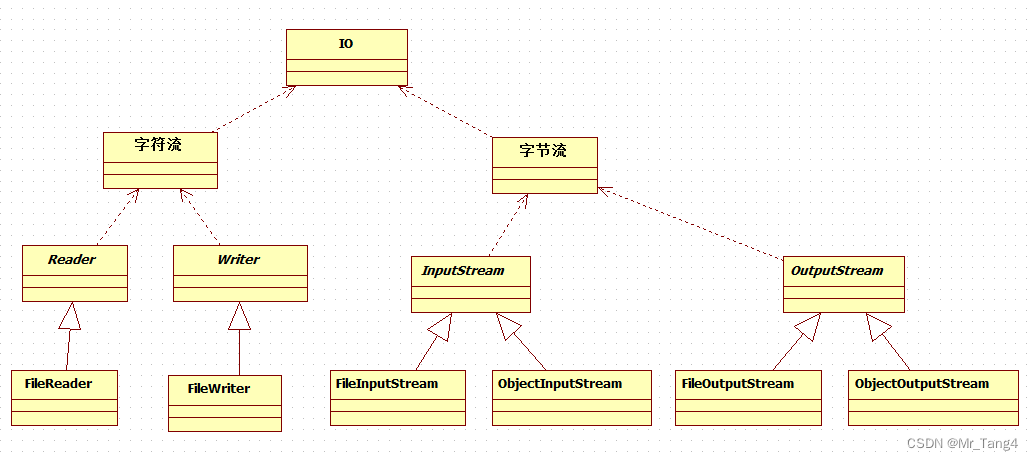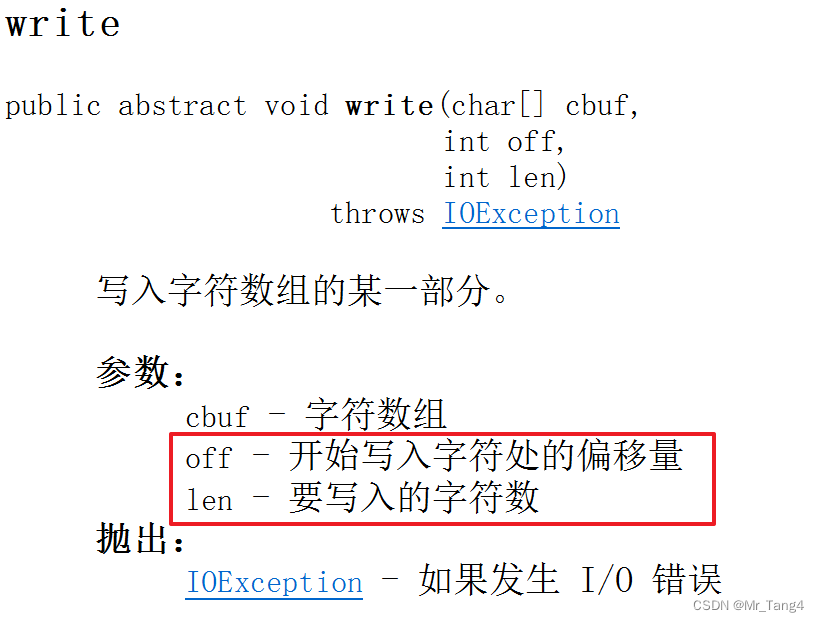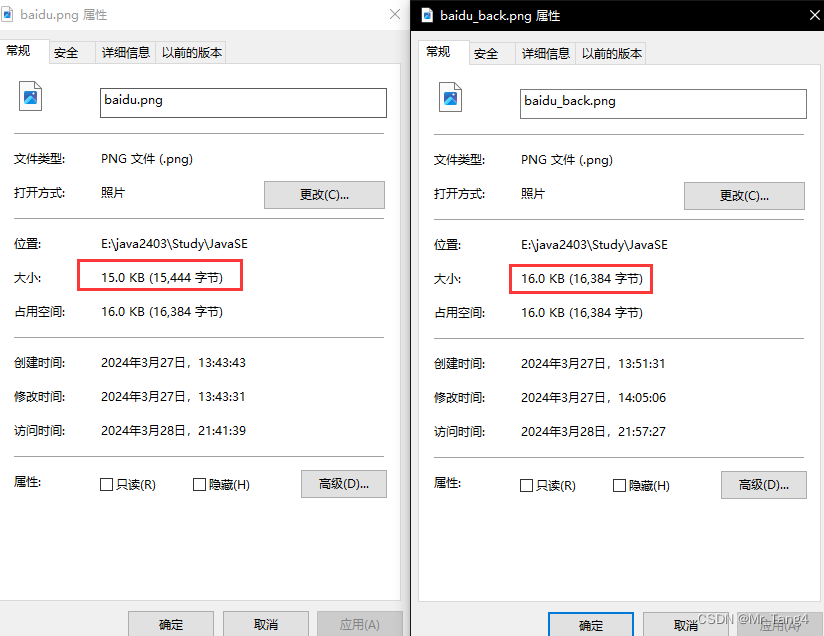本文主要是介绍学点儿Java_Day12_IO流,希望对大家解决编程问题提供一定的参考价值,需要的开发者们随着小编来一起学习吧!
1 IO介绍以及分类
IO: Input Output
流是一组有顺序的,有起点和终点的字节集合,是对数据传输的总称或抽象。即数据在两设备间的传输称为流,流的本质是数据传输,根据数据传输特性将流抽象为各种类,方便更直观的进行数据操作
1.1 IO流的分类
1. 根据处理的数据类型不同可以分为:字符流和字节流。
2. 根据数据的流向不同可以分为:输入流和输出流。


1.2 字节流(Byte Stream)
1.字节流以字节为单位进行读取和写入操作,适合处理二进制数据(如图片、视频、音频等)或者文本文件。
2.字节流类通常以 InputStream 和 OutputStream 结尾,例如 FileInputStream、FileOutputStream。
3.字节流可以用于读写任何类型的文件,但对于文本文件的处理可能需要做字符编码转换。
1.3 字符流(Character Stream)
1.字符流以字符为单位进行读取和写入操作,适合处理文本数据。字符流会自动处理字符编码转换,避免了字节流在处理文本时可能出现的乱码问题。
2.字符流类通常以 Reader 和 Writer 结尾,例如 FileReader、FileWriter。
3.字符流适合处理文本文件,能够更方便地读写文本中的字符数据。
1.4 选择建议
1.如果你需要处理文本文件,推荐使用字符流,因为它们能够更好地处理字符编码和文本数据。
2.如果需要处理二进制文件或者未经处理的数据,应该使用字节流。
2 字符流
@Testpublic void test1() {FileReader fileReader = null;//声明放在外边 局部变量必须初始化//FileReader fileReader;//声明放在外边 ×××××try {fileReader = new FileReader("io.txt");//打开水龙头//Reads a single character.int ch1 = fileReader.read();System.out.println((char)ch1);//aint ch2 = fileReader.read();System.out.println((char)ch2);//bint ch3 = fileReader.read();System.out.println((char)ch3);//cint ch4 = fileReader.read();System.out.println((char)ch4);//System.out.println(ch4);//-1} catch (FileNotFoundException e) {e.printStackTrace();} catch (IOException e) {e.printStackTrace();} finally {//在finally里边必须关闭IO流try {fileReader.close();} catch (IOException e) {throw new RuntimeException(e);}}}@Testpublic void test2() {try {FileReader fileReader = new FileReader("io.txt");int ch = -1;while ((ch = fileReader.read()) != -1) {System.out.println((char)ch);}} catch (FileNotFoundException e) {throw new RuntimeException(e);} catch (IOException e) {throw new RuntimeException(e);}}//----------Day12---------------@Testpublic void test3() {try {FileReader fileReader = new FileReader("io.txt");char[] buffer = new char[10];int length = -1;//public int read(char[] cbuf)//一次将10个字符读入到buffer数组里面//返回:读取的字符数,如果已经达到流的末尾,返回-1while ((length = fileReader.read(buffer)) != -1) {System.out.println(length);System.out.println(buffer);}} catch (FileNotFoundException e) {throw new RuntimeException(e);} catch (IOException e) {throw new RuntimeException(e);}}@Testpublic void test4() {//父类FileReader fileReader = null;FileWriter fileWriter = null;try {fileReader = new FileReader("io.txt");fileWriter = new FileWriter("io_back.txt");char[] buffer = new char[10];int length = -1;//public int read(char[] cbuf)//一次将10个字符读入到buffer数组里面//返回:读取的字符数,如果已经达到流的末尾,返回-1while ((length = fileReader.read(buffer)) != -1) {System.out.println(length);System.out.println(buffer);//读出多少写多少,最后一次读出来的数据很有可能不够buffer数组的长度fileWriter.write(buffer, 0, length);}} catch (FileNotFoundException e) {throw new RuntimeException(e);} catch (IOException e) {throw new RuntimeException(e);} finally {//先打开的后关闭if (fileWriter != null) {try {fileWriter.close();} catch (IOException e) {throw new RuntimeException(e);}}if (fileReader != null) {try {fileReader.close();} catch (IOException e) {throw new RuntimeException(e);}}}}
3 字节流

@Testpublic void test5() {//FileInoutSteam 父类是InputSteamFileInputStream fileInputStream = null;//经验 先生命成null 局部变量必须初始化FileOutputStream fileOutputStream = null;try {fileInputStream = new FileInputStream("baidu.png");fileOutputStream = new FileOutputStream("baidu_back.png");byte[] buffer = new byte[1024];int length = -1;while ((length = fileInputStream.read(buffer)) != -1){//赋值语句有结果 结果就是length值System.out.println(length);//fileOutputStream.write(buffer, 0, length);//这个不会多写fileOutputStream.write(buffer);//会多写几个字节}} catch (FileNotFoundException e) {throw new RuntimeException(e);} catch (IOException e) {throw new RuntimeException(e);} finally {if (fileOutputStream != null) {try {fileOutputStream.close();} catch (IOException e) {throw new RuntimeException(e);}}if (fileInputStream != null) {try {fileInputStream.close();} catch (IOException e) {throw new RuntimeException(e);}}}}


4 对象流
ObjectInputStream、ObjectOutputStream
将对象写入文件的操作流ObjectOutputStream,称为序列化。
从流中读取对象的操作流程ObjectInputStream,称为反序列化。
java.io.NotSerializableException: com.situ.day13.Student
Serialize:序列化
/** 适度编码益脑,沉迷编码伤身,合理安排时间,享受快乐生活。* Copyright @TangXJ* Created by TangXJ* Created&Used date: 2024/3/27 下午2:06 ~ 2024/3/27 下午3:39* Modified date: 2024/3/27 下午3:39*/package com.sdust.day12;import org.junit.Test;import java.io.*;public class Student implements Serializable {//实现一个接口private Integer id;private String name;private Integer age;private String gender;public Student() {}public Student(Integer id, String name, Integer age, String gender) {this.id = id;this.name = name;this.age = age;this.gender = gender;}public Integer getId() {return id;}public void setId(Integer id) {this.id = id;}public String getName() {return name;}public void setName(String name) {this.name = name;}public Integer getAge() {return age;}public void setAge(Integer age) {this.age = age;}public String getGender() {return gender;}public void setGender(String gender) {this.gender = gender;}@Overridepublic String toString() {return "Student{" +"id=" + id +", name='" + name + '\'' +", age=" + age +", gender='" + gender + '\'' +'}';}//对象流@Testpublic void test1() {Student student = new Student();student.setId(1);student.setName("zhangsan");student.setAge(23);student.setGender("男");//java.lang.RuntimeException: java.io.NotSerializableException: com.sdust.day12.Student//不能序列化的异常//实现一个接口ObjectOutputStream objectOutputStream = null;//不负责写文件 对象转换交给它ObjectOutputStream来完成//负责把一个对象 做一个转换FileOutputStream fileOutputStream = null;try {fileOutputStream = new FileOutputStream("stu");objectOutputStream = new ObjectOutputStream(fileOutputStream);objectOutputStream.writeObject(student);} catch (FileNotFoundException e) {throw new RuntimeException(e);} catch (IOException e) {throw new RuntimeException(e);} finally {//x先打开的后关闭if (objectOutputStream != null){try {objectOutputStream.close();} catch (IOException e) {throw new RuntimeException(e);}}if (fileOutputStream != null) {try {fileOutputStream.close();} catch (IOException e) {throw new RuntimeException(e);}}}}@Testpublic void test2() {ObjectInputStream objectInputStream = null;FileInputStream fileInputStream = null;try {fileInputStream = new FileInputStream("stu");objectInputStream = new ObjectInputStream(fileInputStream);//Student student = objectInput.readObject();//报错 父类不能转换为子类//Object object = new Student();Student student = (Student) objectInputStream.readObject();System.out.println(student);} catch (FileNotFoundException e) {throw new RuntimeException(e);} catch (IOException e) {throw new RuntimeException(e);} catch (ClassNotFoundException e) {throw new RuntimeException(e);} finally {if (objectInputStream != null) {try {objectInputStream.close();} catch (IOException e) {throw new RuntimeException(e);}}if (fileInputStream != null) {try {fileInputStream.close();} catch (IOException e) {throw new RuntimeException(e);}}}}
}这个Demo运行时要注释掉所有构造函数。
一般情况下:先打开的后关闭,后打开的先关闭。
另一种情况:看依赖关系,如果流A依赖于流B,先关闭流A,再关闭流B。
这篇关于学点儿Java_Day12_IO流的文章就介绍到这儿,希望我们推荐的文章对编程师们有所帮助!







